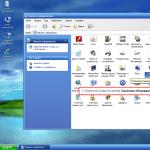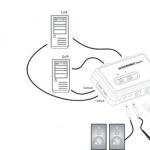Rastegaev Daniil, student of the 9th grade of the MOU-SOSH No. 9 of the city of Atkarsk
AT research project determining the possibility of using lemon as a current source. Its resistivity and efficiency are calculated.
Download:
Preview:
Study of the characteristics of a lemon as a current source
Rastegaev, Daniel
9th grade student
MOU-SOSH №9 Atkarsk
Introduction.
Usage electrical energy is now very closely related to the comfort of human living in modern world. At the same time, the reserves of traditional natural fuels (oil, coal, gas, etc.) are finite. There are also finite reserves of nuclear fuel - uranium and thorium, from which plutonium can be obtained in breeder reactors. Almost inexhaustible reserves of thermonuclear fuel - hydrogen, however, controlled thermonuclear reactions have not yet been mastered and it is not known when they will be used for industrial energy production in pure form. Mankind is looking for alternative sources of obtaining electric current: wind, geothermal water, tidal energy. Or maybe the current sources were created by nature itself? And we just have to find a use for them.
One of these sources is investigated in this paper.
Objective of the project:
Explore the characteristics of a lemon as a current source.
Tasks:
- Familiarize yourself with the concepts of EMF and internal resistance.
- Study Ohm's law for a complete circuit.
- Explain the processes occurring in the lemon, which is used as a current source.
- Experimentally determine the EMF and internal resistance of the lemon, calculate the resistivity of the lemon and the power of the lemon as a current source.
- Consider the possibility of using this current source for practical purposes.
- EMF of the current source.
Electric current is an ordered movement of charged particles. To obtain an electric current in a conductor, it is necessary to create an electric field in it. An electric field in conductors is created and can be maintained long time sources of electric current. There are different types of current sources:
- mechanical (electrophore machine);
- thermal (thermoelement);
- light (photocell);
- chemical (galvanic cell).
Current sources are different, but in each of them work is done to separate positively and negatively charged particles. Any forces acting on electrically charged particles, with the exception of Coulomb forces, are called external forces. Inside the current source, the charges move under the action of external forces, and in the rest of the circuit - under the action of electric field. The nature of outside forces can be varied.
The action of external forces is characterized by an important physical quantity called electromotive force (EMF).
- Lemon is a galvanic element.
Lemon is a small evergreen fruit tree up to 5-8 m high, with a spreading or pyramidal crown. There are trees at the age of 45 years.
Lemon fruits contain citric acid (C 6 H 8 O 7 ). The substance is extremely common in nature: found in berries, citrus fruits, needles, shag stems, especially a lot of it in Chinese magnolia vine and unripe lemons.
Citric acid was first isolated in 1784 from the juice of unripe lemons by the Swedish pharmacist Karl Scheele.
In a lemon, as in a galvanic cell, the nature of external forces is chemical. As a result of a chemical reaction, zinc dissolves in citric acid. Positively charged zinc ions pass into the solution, while the zinc plate itself becomes negatively charged. The copper plate becomes positively charged as zinc ions are deposited on it. (see annex 1)
For measurements and experiments, we will collect electrical circuit according to the scheme:
- Ohm's law for a complete circuit.
Consider the electrical circuit for our experiment.
The current source has an EMFɛ and resistance r. The resistance of the current source is often called internal resistance, the resistance of the external section of the circuit is denoted R.
Georg Simon Ohm (March 16, 1787 - July 6, 1854) - famous German physicist. Ohm's most famous work dealt with questions about the passage of electric current and led to the famous "Ohm's law" relating the resistance of an electric current circuit, internal resistance and EMF of a current source, current strength.
Ohm's law for a complete circuit:
The current strength in an electric circuit is directly proportional to the electromotive force of the current source and inversely proportional to the sum of the electrical resistances of the external and internal sections of the circuit.
- Experiment results.
Let's assemble an experimental circuit to obtain the necessary data. (see annex 2)
Let's measure the emf of a lemon:ɛ = 0.95V
Let's measure the current strength and voltage in the circuit section with different external resistance.
U 1 \u003d 0.515V U 2 \u003d 0.586V
I 1 \u003d 196 μA I 2 \u003d 160 μA
R 1 \u003d 2 kOhm R 2 \u003d 3 kOhm
According to Ohm's law, for a complete circuit, the internal resistance of a lemon was calculated: r \u003d 2.1 kOhm. (see annex 3)
Let's measure the current short circuit on lemon: I kz \u003d 460 μA. The short-circuit current has a maximum value when the external resistance of the circuit is R→0.
Using the obtained measurements, we calculated the resistivity of the lemon ƍ=69*10 6 Ohm*mm 2 / m. (see annex 3)
Also determined the efficiency and power of the lemon as a current source
P=108.3*10 -6 W
Ƞ= 60%
Despite enough great importance Efficiency, the power of a lemon as a current source is very small.
We tried to use a lemon as a current source. We assembled an electrical circuit from several lemons and a diode connected in series. Several lemons connected in series serve as batteries of galvanic cells. At serial connection the current strength that such a source gives out remains unchanged, and the voltage is equal to the sum of the voltages at the terminals of the individual sources. With the help of 5 lemons connected in series, we were able to light two LEDs.
Conclusion.
- Lemon is a galvanic element in which chemical external forces act.
- Lemon can be used as a source of electric current.
- For domestic purposes, a lemon cannot be used as a current source, since the current that a lemon produces is on the order of several tens of microamperes, while it has a very high internal resistance.
References and other sources:
- A.V. Peryshkin Physics grade 8. M: Bustard, 2009
- G.Ya. Myakishev, B.B. Bukhovtsev, N.N. Sotsky Physics grade 10, M: "Enlightenment" 2007
- M.N. Alekseeva Physics - young. M: "Enlightenment" 1980.
- I.G. Kirillov Book for reading in physics. M: "Enlightenment", 1986.
- http://en.wikipedia.org
Attachment 1
Annex 2
Annex 3
We calculated that the internal resistance of the lemon is r = 2.1 kΩ.
We calculated that the length between the plates l \u003d 3.8 cm \u003d 0.038 m.
Determined the area of the plates a= 39mm b= 32mm S=ab= 1248mm 2
Now we find the resistivity of a lemon using the formula:
For lovers of all kinds of experiments and experiments, we offer an unusual idea - try to build with my own hands a primitive battery of sour lemons. We spend a lot of money on batteries, accumulators to power phones, watches, toys, without thinking at all that we are surrounded by a mass of inexpensive energy sources, from which we can assemble an economical and simple galvanic cell with our own hands at any time. We do not even imagine how many interesting things surround us!
To conduct the experiment, we need, as I mentioned above, lemons (8 pieces), 9 thin wires with clamps, 8 small pieces of copper wire and the same number of galvanized nails, a watch with a battery, and, of course, a voltmeter to test the possibilities ( voltage) of the battery we built.
Having lightly stretched the lemons in our hands, we stick a piece of copper wire and one galvanized nail into each of them. We take a watch, remove the battery from it, and with the help of wires we create an electrical circuit, as in the picture. We connect the free ends of the wires from the first and eighth lemons to the clock in the places where the battery was previously, creating a closed circuit. At the end of the experiment, we will see how the clock will go. By connecting the ends of the wires to a voltmeter, we can observe a voltage of 0.49 V.
It is easy to explain how our fruit battery works. When copper and zinc come into contact with citric acid, a chemical reaction occurs, as a result of which copper becomes positively charged, and zinc becomes negatively charged. With a closed circuit created with copper wire and small galvanized nails, an electric current begins to act. Zinc (source of electrons) is the negative pole fruit battery, copper is positive. Battery voltage is related to the ability of zinc and copper to donate electrons. The electric current depends on the number of electrons released during the chemical reaction being run.

If there are no lemons at home, any other citrus fruits, kiwi, bananas, apples, pears, potatoes, tomatoes, cucumbers, onions can be used as the main material for the experiment. These vegetables and fruits can also work as a battery, although their voltage will be slightly different from a lemon current source. The pear will give the highest voltage, the kiwi will give the lowest. For electrical specifications created batteries influenced by the acidity of the products used. By connecting several fruit batteries in series, we will achieve an increase in voltage in proportion to the amount of fruit used.
A pair of copper and zinc can be replaced with other components, for example, copper and aluminum, aluminum and zinc. True, in the latter case, the battery will turn out to be somewhat weaker than the "original" lemon one.
The above experiment is a direct confirmation that a person can freely use natural renewable materials to meet their energy needs. A number of companies on an industrial scale have already begun to create unusual batteries with the use of processed bananas, orange peels. The Sony company recently presented to the public a battery in which fruit juice is used instead of an electrolyte. By filling the battery with 8 ml of juice, you can power small portable electronics for one hour. Scientists from the UK have created a similar version of the battery for a low-power computer with an Intel 386 processor. It has been experimentally proven that 12 potatoes can become a full-fledged source of energy for a computer within 12 days.
MBOU « Average comprehensive school No. 6 in Yurga "
Section: The world of my interests.
Fruit Battery.

MBOU secondary school No. 6, student of grade 4
Head: Belonosova T.V.
Yurga
2015
l Introduction.
ll. Main part.
How does a battery work.
Practical use of the battery to.
lll. Conclusion.
lV . Bibliography.
V. Application.
l Introduction.
M  My work came about thanks to my passion for books and the desire to make crafts. For the first time I read about the non-traditional use of fruits in a book by Nikolai Nosov. As conceived by the writer, Shorty Vintik and Shpuntik, who lived in the Flower City, created a car that runs on soda with syrup.
My work came about thanks to my passion for books and the desire to make crafts. For the first time I read about the non-traditional use of fruits in a book by Nikolai Nosov. As conceived by the writer, Shorty Vintik and Shpuntik, who lived in the Flower City, created a car that runs on soda with syrup.
And then I thought, what if fruits also keep some secrets.
I wanted to learn as much as possible about the unusual properties of fruits. Scientists say that if the electricity goes out in your house, you can light up your house with lemons for a while.
Purpose of my research:
Getting electric current from fruits.
Tasks are shown on the slide.
1. Familiarize yourself with the principle of battery operation.
2. Create fruit batteries.
3. Experimentally determine the voltage of such batteries.
4. Try to light a light bulb with a fruit battery.
Subject of study: receiving electric current.
Object of study: fruit batteries.
G  mortgage:
mortgage:
Are fruits a source of electricity? Is it possible to make a battery out of fruit?
ll. Main part.
How does a battery work.

First, let's understand what an electric current is. Electric current is the movement of electrically charged particles. I decided to find out how a regular battery works. I did not disassemble the battery myself, I used the encyclopedia. Any battery or accumulator is two metal plates placed in a special chemical substance - an electrolyte. One plate is connected to the "+" terminal, the other to the "-" terminal.

Battery is a convenient storage of electricity that can be used to power portable devices. Some batteries are single use, others can be recharged. Batteries come in a variety of shapes and sizes. Some are small, like a pill. Some are the size of refrigerators. But they all work on the same principle. They create electric charge a reaction between two chemicals in which electrons are transferred from one to the other.
Zinc (galvanized plate) and copper (copper wire) are used as electrodes, and the electrolyte is a solution of salts and acids. Two metals immersed in a solution enter into a chemical reaction and an electric current is generated.
The first source of electric current was invented by accident, at the end of the 17th century, by the Italian scientist Luigi Galvani (in fact, the purpose of Galvani's experiments was not to search for new sources of energy, but to study the reaction of experimental animals to various external influences). The phenomenon of the appearance and flow of current was discovered by attaching strips of two different metals to the muscle of the frog's leg.
Galvani's experiments became the basis for the research of another Italian scientist, Alessandro Volta. 200 years ago he formulated the main idea of the invention.
 Invented 200 years ago, the very first battery worked on the basis of fruit juice.
Invented 200 years ago, the very first battery worked on the basis of fruit juice.
Alessandro Volta made a discovery in 1800 by assembling a simple device from two metal plates (zinc and copper) and a leather gasket between them soaked in lemon juice.
Alessandro Volta discovered that there is a potential difference between the plates. The unit of voltage measurement was named after this scientist, and his fruit energy source became the progenitor of all current batteries, which are now called galvanic cells in honor of Luigi Galvani.

On the Internet, I saw a photo that shows a device that you can assemble with your own hands. This is a digital watch that uses fruit instead of a battery.
I conducted a survey among students in my class to find out what they know about batteries about the existence of a fruit battery.
What is in a battery?
Based on the results of the questionnaire, I can conclude that: the guys know what is contained inside the battery and how it works. And the guys heard about the fruit battery. (Fig. 1)
Fruit juice in its composition is a weak acid, so if you insert 2 electrodes into the fruit: one copper - the other zinc, then a weak current will flow between the electrodes, sufficient to power the watch. But I'm not used to taking a word, so I decided to personally check whether it's true or not.
Battery experiment.
To create fruit batteries, I needed:
M  materials:
materials:
Galvanized plate


A multimeter is a device for measuring current and voltage.

4. Fruits.
I'm starting to measure the current in fruit.
With the help of my dad, I made galvanic cells from pear, apple and lemon. Each element was measured with a multimeter. (fig.2)
We were surprised that lemon, pears and apples give electricity! I entered the results of voltage measurements in the table. (fig.3)
I found out that the usual AA battery gives 1.5 volts.
So, the hypothesis was confirmed: different fruits give a different current in strength.
V. Application.
Picture 1.
Questionnaire.
What is in a battery?
All the guys answered yes to this question.
Are there fruit batteries?

Figure 2.
We take a pear on one side, insert a copper wire, and on the other, a zinc plate.

The battery is ready, we measure the voltage.

We take an apple on one side, insert a copper wire, and on the other, a zinc plate. The battery is ready, we measure the voltage.

We take a lemon on one side, insert a copper wire, and on the other, a zinc plate. The battery is ready, we measure the voltage.

An ordinary penlight battery gives 1.5 volts.


Figure 3
Voltage measurement results.
Fruit
Voltage, V
Pear
0.90
Apple
0.87
Lemon
0.90
Figure 4
They took a small led light bulb. Connected it to the contacts of the lemon.


My blue LED starts to glow!

It happens that you find yourself in a difficult life situation when you urgently need a source of energy. For example, you need to charge your mobile phone, turn on the radio, and so on. Elementary knowledge of physics and chemistry will allow you to find a way out of such situations. For many, it will be interesting to know that you can “power up” a radio or charge a mobile phone from an apple or a lemon.

For these purposes you will need:
- steel contact (nail, paper clip, piece of steel wire, steel coin and so on...);
- copper contact (copper coin, piece of copper wire, any copper plate, etc.);
- lemon, and if an apple is used, you need to choose as sour as possible;
- two wires for connecting to the "battery".

Procedure:
Stage 1. Looking for a suitable "energy source"
The easiest way is to find an apple when you are in a country house, village, or simply lost in the forest. Best Option there will be a sour apple, since acid is a key component in the work of the "battery". If there is a lemon, then this is the most suitable option. You can also use oranges, kiwi and other similar fruits.

Stage 2. We establish contacts
You need to insert contacts into a lemon or an apple, first they need to be thoroughly cleaned with sandpaper, a file, or rubbed against a stone. Contacts are inserted at a distance of 2-3 centimeters from each other. The wider and longer the inserted electrodes, the more voltage the battery will produce. If coins act as contacts, then they must be inserted in parallel.

Stage 3. We connect the battery
Now it remains to connect two wires to established contacts. You can simply gently stick them into a lemon or apple along with the contacts. That's it, the battery is ready to use. There will be a plus on the copper electrode, and a minus on the steel. The voltage will depend on the area of the electrodes and the acidity of the apple or lemon.


One such battery is capable of delivering about 0.5-0.8 volts. In order for a simple receiver to work or a mobile one to charge, a voltage of at least 3-5 volts is required. To get such power, you need to make several of these "batteries" and connect them in series. In our case, to get 3 Volts, you need about 5-6 of these "batteries".

Stage 4. Charging lemons
An interesting fact is that the "batteries" created in this way can be fully charged. For these purposes, you can use charger from mobile phone. The author decided to use a Krona battery for these purposes.
The red positive wire is connected to the copper electrode, and the black negative wire to the steel one. After charging, a voltage of 1-1.3 Volts will appear on the contacts of the "lemon".




